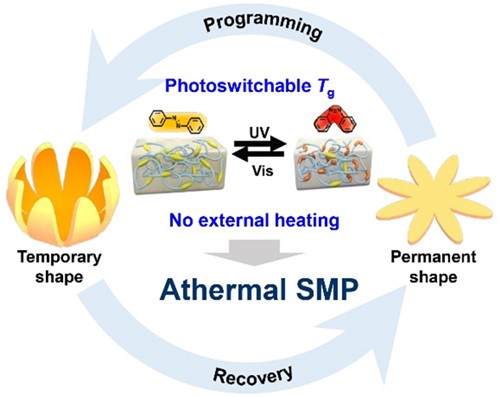搜索
Title: Rapid, Localized, and Athermal Shape Memory Performance Triggered by Photoswitchable Glass Transition Temperature
Author: Xiao Zhang, Chongyu Zhu, Bo Xu, Lang Qin, Jia Wei, Yanlei Yu*
Journal: ACS Appl. Mater. Interfaces, 2019, 11(49), 46212-46218
Abstract:
Shape memory polymers that undergo shape recovery at room temperature (RT) are desirable for their potential in vivo applications, yet challenging. Herein, light-triggered athermal shape memory effect of azopolymer networks is reported by photoswitching the glass transition temperature (Tg) rather than external heating. Thanks to the switchable Tg of azopolymer induced by reversible trans−cis isomerization, the entropic energy is trapped in low Tg state (cis-form Tg < RT) to deform into a temporary shape and fixed in high Tg state (trans-form Tg > RT). Upon exposure to UV light, the reduced low Tg allows release of the entropic energy, realizing athermal shape recovery of the permanent shape. By exploring the shape memory performance, we demonstrate diverse light-induced rapid shape recovery from temporary shape to original shape. Because of the instant, precise, and spatiotemporal manipulation of light, programmable shape recovery of surface topography is further extended. We anticipate that this strategy will provide tremendous opportunities for future precise medicine devices and soft robotics.
论文链接:https://pubs.acs.org/doi/abs/10.1021/acsami.9b17271

在此,我们报道了一种通过光切换Tg的方法来在含偶氮苯聚合物网络(APN)中实现光致无热形状记忆效应的策略。由于偶氮苯基团的光致trans-cis异构化使得Tg产生变化,熵能可以通过橡胶态和玻璃态之间的转换来被储存和释放。同时,动态酯键的酯交换使得交联的APN在加热时通过网络拓扑结构的重排很容易重塑为薄膜和不同的3D结构(波斯菊、人工含羞草)。由于光具有瞬时、精确操纵的特点,表面形貌的可编程形状记忆得到进一步扩展,为未来的精准医疗设备和软机器人提供巨大的机会。








